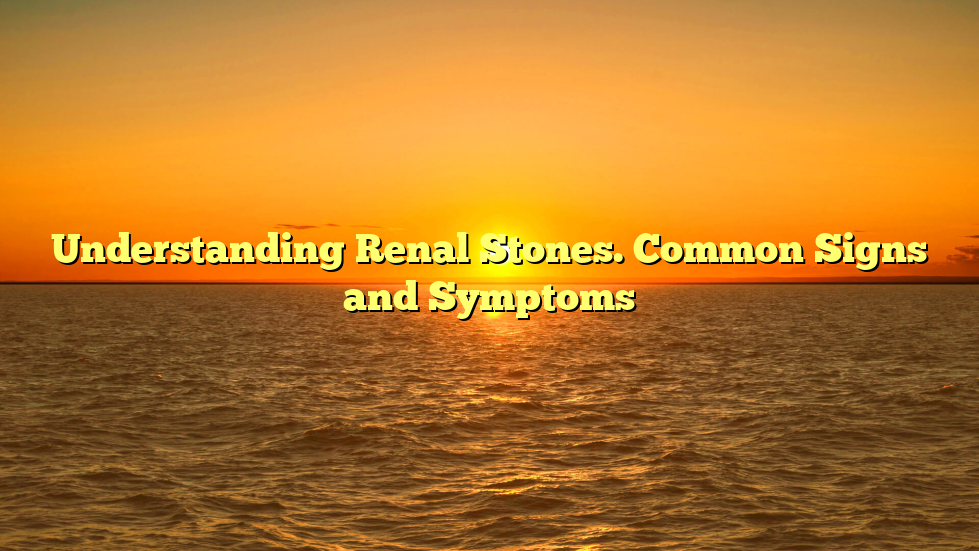
Renal stones, also known as kidney stones, are a common medical condition affecting millions of people worldwide. These small, hard deposits form in the kidneys and can cause severe pain and discomfort if left untreated. Recognizing the signs and symptoms of renal stones is crucial for early detection and timely intervention. In this blog post, we will explore the various signs that may indicate the presence of renal stones in the body.
1. What are Renal Stones?
[Provide a brief explanation of what renal stones are, including their formation, composition, and risk factors.]See more Product at Memorial Sign World
Renal stones are solid formations that develop within the kidneys. They are typically made up of various substances such as calcium, oxalate, uric acid, or cystine. Renal stones can vary in size, ranging from tiny grains to larger, more prominent stones.
Certain factors increase the risk of developing renal stones, including dehydration, a diet high in sodium or oxalate, obesity, family history, certain medical conditions (such as urinary tract infections or gout), and certain medications. Understanding these risk factors can help individuals take preventive measures to reduce the likelihood of developing renal stones.
See More Memorial Sign World Articles:
- Under Canvas Pet Policy. Everything You Need to Know for a Paw-some Camping Experience
- Understanding Long-Term Memory Loss. Is it a Sign of Dementia?
2. Common Signs and Symptoms of Renal Stones
[Discuss the signs and symptoms that individuals may experience when they have renal stones.]-
Intense Back or Abdominal Pain. One of the most common signs of renal stones is sharp, severe pain in the back or abdomen. This pain can be intermittent or constant and may radiate to the groin area. The intensity of the pain can vary depending on the size and location of the stone.
-
Blood in Urine. Renal stones can cause bleeding in the urinary tract, leading to blood in the urine (hematuria). The urine may appear pink, red, or brownish in color. It’s important to note that blood in urine can also be a sign of other underlying medical conditions, so a proper diagnosis is essential.
-
Frequent Urination. Individuals with renal stones may experience an increased frequency of urination. This can be due to irritation or blockage caused by the stone in the urinary tract.
-
Urinary Urgency. Along with increased frequency, individuals may also experience a sense of urgency to urinate. This can be accompanied by a feeling of incomplete emptying of the bladder.
-
Cloudy or Foul-Smelling Urine. Renal stones can lead to urinary tract infections (UTIs), which can cause changes in urine appearance and odor. Cloudy or foul-smelling urine may indicate an infection and should be evaluated by a healthcare professional.
-
Nausea and Vomiting. Some individuals with renal stones may experience nausea and vomiting. This can be a result of the severe pain or due to the body’s response to the presence of a stone.
-
Fever and Chills. In cases where a renal stone leads to a urinary tract infection, individuals may develop a fever along with chills. This indicates an infection that requires immediate medical attention.
-
Painful Urination. Renal stones can cause discomfort and pain during urination. This symptom is often attributed to the irritation caused by the stone as it passes through the urinary tract.
3. When to Seek Medical Attention
[Explain when it is necessary to seek medical help for suspected renal stones.]If you experience any of the following signs and symptoms associated with renal stones, it is crucial to seek immediate medical attention:
- Severe, unrelenting pain in the back or abdomen
- Blood in urine
- Persistent nausea and vomiting
- High fever accompanied by chills
- Inability to pass urine
- Intense pain while urinating
- Signs of dehydration (e.g., dry mouth, decreased urine output)
Ignoring these symptoms or delaying treatment can lead to complications such as infection, kidney damage, or obstruction of the urinary tract.
4. Diagnosis of Renal Stones
[Discuss the diagnostic procedures used by healthcare professionals to confirm the presence of renal stones.]To diagnose renal stones, healthcare professionals may employ various methods, including:
-
Medical History and Physical Examination. The healthcare provider will gather information about your symptoms, medical history, and conduct a physical examination to assess for signs such as tenderness in the abdomen or lower back.
-
Urinalysis. A urine sample is analyzed for the presence of blood, infection, or other abnormalities that may indicate renal stones or associated conditions.
-
Imaging Tests. Imaging techniques like X-rays, ultrasounds, or CT scans are commonly used to visualize kidney stones and determine their size, location, and composition.
-
Blood Tests. Blood tests may be conducted to assess kidney function and identify any underlying conditions contributing to renal stone formation.
5. Treatment Options for Renal Stones
[Provide an overview of the available treatment options for renal stones.]Treatment for renal stones depends on factors such as the size, location, and composition of the stone, as well as the severity of symptoms. The following treatment options are commonly utilized:
-
Medication. In some cases, medications may be prescribed to help dissolve smaller stones or manage symptoms such as pain or infection.
-
Increased Fluid Intake. Drinking plenty of water and fluids can help flush out small stones from the kidneys and prevent their formation.
-
Extracorporeal Shock Wave Lithotripsy (ESWL). This non-invasive procedure uses high-energy shock waves to break larger stones into smaller fragments that can be passed naturally.
-
Ureteroscopy. A thin tube equipped with a camera is inserted through the urethra and bladder to reach and remove or break up stones located in the ureter or kidney.
-
Surgical Intervention. In cases where other treatments are ineffective or not feasible, surgical intervention may be necessary to remove or fragment larger stones.
Conclusion:
[Summarize the key points discussed in the blog post and emphasize the importance of recognizing signs and symptoms for early intervention.]Recognizing the signs and symptoms of renal stones is crucial for early detection and timely treatment. If you experience any symptoms associated with renal stones, it is important to consult a healthcare professional for an accurate diagnosis and appropriate management. By understanding these common signs, individuals can take proactive steps towards maintaining kidney health and preventing complications associated with renal stone formation. Remember, early intervention can make a significant difference in managing this condition effectively.
#memorialsignworld, #memorialsignworldstore,#MetalMonogramSigns, #PetMemorialCanvas, #ChickenCoopSign/

